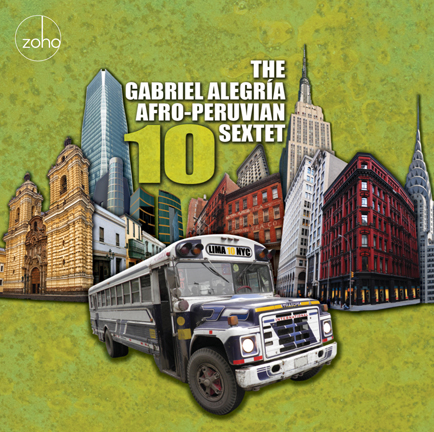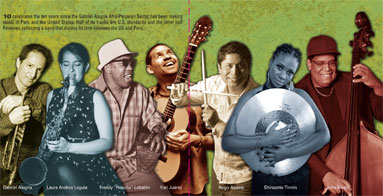|
The Gabriel Alegria Afro-Peruvian Sextet
10
Release Date: August 7, 2015
Selection #: ZM 201509
UPC Code: 880956150925
Availability: Worldwide
Songs:
1. CARAVAN 6:05
2. TAKE FIVE / EL CONDOR PASA 6:06
3. TAITA GUARANGUITO 7:21
4. MY FAVORITE THINGS 6:34
5. BIRDLAND 5:25
6. HIMNO NACIONAL DEL PERÚ 4:06
7. LONELY WOMAN 6:55
8. CONTIGO PERÚ 6:48
9. HOMENAJE A CHINCHA 5:17
10. THE STAR SPANGLED BANNER 3:45
_
|
Musicians:
Gabriel Alegría - trumpet, flugelhorn, guapeo, vocals
Laura Andrea Leguía - soprano and tenor saxophones, guapeo, vocals
Freddy "Huevito - Lobatón - cajón, quijada, cajita, campana, guapeo, vocals
Yuri Juárez - acoustic and electric guitars, vocals
Hugo Alcázar - drums, guapeo, vocals #1 - 4, 6 - 8
Shirazette Tinnin - drums #5, 9, 10
Ron Carter - double bass #1, 4, 8
John Benitez - double bass #2, 3, 7
Essiet Essiet - double bass #5, 6, 9, 10
Russell Ferrante - keyboards #6, 8
Arturo O’Farrill - piano #6, 10
Felix Valdelomar - guapeo, vocals #3, 7
Octavio Castillo - steel guitar #3, kalimba # 9
Daniel Susnjar - second drum set #7
Pepe Villalobos - guapeo, vocals #3
Rosita Guzmán - guapeo, vocals #3
Gustavo Urbina - guitar, vocals #8
Badal Roy - tablas #6, 9, voice of the drum #9
|
 |
|
10 marks the ten years since the Gabriel Alegría Afro-Peruvian Sextet has been making music in Perú and the United States. Half of its tracks are U.S. standards and the other half Peruvian, reflecting a band that divides its time between the US and Perú. Instruments that typify jazz such as the drumset, double bass, trumpet and saxophone fuse with Afro-Peruvian instruments including the cajón, cajita (a small wooden box with a flappable top), the quijada (the jawbone of an ass), and vocal interjections known as guapeo. The acoustic guitar, a familiar instrument in both traditions, knits it all together. 10 is a musical experience entirely its own, one that finds and articulates the affinities between cultures and traditions of the two countries that the band calls home.
The ten tracks of 10 comprise twice that number of musicians, carefully positioned in the arrangements, including a choir of Peruvian children. Gabriel Alegría’s trumpet is instantly recognizable in its summoning call, while tenor and soprano saxophonist Laura Andrea Leguía gives breath, as always, to the band’s infectious, almost spiritual energy. Master percussionist Freddy “Huevito” Lobatón threads the album with its intricate rhythms, along with those of the band’s assured Lima-based drummer Hugo Alcázar. The criollo guitar of Yuri Juárez has a distant allure, almost as if he were painting a mental landscape of his home country. Alternating on double bass are band stalwart John Benitez, the Nigerian-American Essiet Essiet, and, in resonant guest takes on three tracks, the legendary Ron Carter. Shirazette Tinnin, a North American regular, and Daniel Susnjar, a sharp and witty Australian, take their turns, along with Alcázar, on the drums. Latin jazz star Arturo O'Farrill lends his piano to two tracks, and Russell Ferrante keyboards to two others. There is additional steel guitar and calimba work from Octavio Castillo and criollo guitar inflections from Gustavo Urbina and Milton Mendietta. Vocal tracks and effects are contributed by Felix Valdelomar, Pepe Villalobos, Rosita Guzmán, Urbina, and the Coro de Niños. The venerable Miles Davis alumn Badal Roy on tablas caps off the guest list to this lively celebration, open to all and not to be missed, of a decade of music making.
One way to think of 10 is as a call and response across musical borders and national boundaries. It starts off with a grinding festejo groove on Juan Tizol and Duke Ellington’s Caravan and alternates from there, one or two at a time, between Peruvian and U.S. numbers. Some are the deeply Peruvian, like the traditional Taita Guaranguito, which establishes landó as a motif early on, in track 3.
Others are of North American origin, like Lonely Woman, a gorgeously transformed Ornette Coleman classic. Birdland is a fusion masterpiece with a Peruvian connection through Alex Acuña of Weather Report, to whom the Sextet pays homage. Another sort of homage is paid, in Homenaje a Chincha, a Peruvian hit written by the band’s maestro of percussion and zapateo, Freddy “Huevito” Lobatón, to one of the centers of Afro-Peruvian culture, which includes the striking tablas and “voice of the drum” of Badal Roy.
The arrangements emphasize Afro-Peruvian rhythms within the overall form of North American jazz and are remarkable for being both erudite and accessible. They are deeply entertaining to listen to, as well as moving, not just inspiring but playful, teasing us with recognizable passages from the originals only to reconstitute them in new and intriguing ways.
There could not, for example, be two more familiar tunes from either Perú or the United States than the ones sharing the second track in Take Five/El Condor Pasa, yet the arrangement toys, in a fascinating way, with just when the two overlap and when they are separate. It’s as though there were a hidden affinity between the songs that has always been there and which the Sextet has let us hear for the first time. At other times, the sense of familiarity provides an anchor that lets the ear attune itself to fusion and experimentation. Rodgers and Hammerstein’s My Favorite Things is recognizable to virtually any North American listener, making it easy to appreciate the playfulness with which it is deconstructed and recomposed with an Afro-Peruvian sensibility. |
 Familiar Peruvian standards are quoted throughout the band’s improvisational foray, appearing and disappearing in a tantalizing interplay of cultural references. It isn’t necessary, however, to know a song in advance to experience it as though it were familiar. Not every non-Peruvian will know Augusto Polo Campos’ Contigo Perú, but hearing it on 10 evokes an undeniable love of place. Familiar Peruvian standards are quoted throughout the band’s improvisational foray, appearing and disappearing in a tantalizing interplay of cultural references. It isn’t necessary, however, to know a song in advance to experience it as though it were familiar. Not every non-Peruvian will know Augusto Polo Campos’ Contigo Perú, but hearing it on 10 evokes an undeniable love of place.
The National Anthems of both countries are represented, in arrangements that bespeak a nostalgia, or homesickness, for places and people left behind, even if, as would be case with the band, it is temporary. The Himno nacional del Perú and The Star Spangled Banner are the middle (6) and ending (10) tracks, respectively. The former is quintessentially anthemic and stirring: you would know it was a national anthem without consulting the track title.
The band’s version of the “The Star Spangled Banner” is beautifully reflective, resolving an initial sadness in a reverie that builds to a point of joy that dissolves, with the album itself, into memory. By then the tune seems no longer familiar, but something made strange and wonderful.
Such effects are everywhere on 10, all the more striking in their clarity given the richness of the arrangements, jazz versions, generally, of traditional rhythms like landó, vals, and festejo. This continues the distinctive integration of North American jazz and Afro-Peruvian music pursued by the Sextet in ten years of live performance and on four previous self-released albums, Nuevo Mundo (2008), Pucusana (2010), Afro-Peruvian Jazz Secrets (2012), and City of Kings, or Ciudad de Los Reyes (2013). Following on the others, 10 feels like both celebration and summation. It has an immediacy that is truly remarkable. There is a multiplier effect to the many sources of its sound, and they connect in the ear to just as many people, a living, breathing crowd in a space as vivid and alive as in any hall in which the Sextet has actually played. You don’t “have to have been there,” as the expression goes, because 10 creates a space and puts you there.
In some ways the album reflects Alegría’s own life history. He was born in Perú and raised in a family that, he once joked to a radio interviewer, would have disapproved if he had come to them and announced a desire to be a lawyer or accountant. He is the grandson of Ciro Alegría, the novelist and activist whose work focused on the lives of Perú’s indigenous peoples, and his father, Alonso Alegría, is a leading Peruvian playwright. Gabriel gravitated to music, the first in his family to do so professionally, starting in high school and later at the National Conservatory and Lima Philharmonic. He moved to Ohio to attend Kenyon College, finished a master’s degree in jazz at City College of New York and received a doctorate from the University of Southern California, where the Sextet was born in 2005. Five albums later, its primary founder now a Professor of Jazz Studies at New York University, the Sextet commemorates that signal moment with the release of 10.
-- John Osburn
Produced by: Daniel Susnjar, Laura Andrea Leguía, Yuri Juárez, Freddy “Huevito” Lobatón, Hugo Alcázar, Kabir Sehgal. Mixed by : Julio Ortega. Recording engineer: Paul Geluso. Assistant engineers: Hsin Hwa Tai, Katherine Pipal, Luca Bruegger, Mike Tierney. Mastering engineer: Alan Silverman. Production Assistants: Mark Sundermeyer, Andrés López. Recorded at James L. Dolan Studio, New York City, in October 2014. Mixed at Saponegro in Lima, Perú, January / February 2015. Mastered at ARF Mastering, New York City, in February / March 2015. Photography by: Bex Wade. Art direction and package design by: Jack Frisch. Executive Producers: Gabriel Alegría, |
|
|
|

